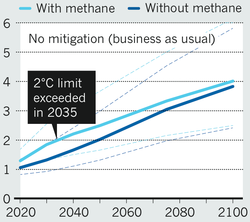Why the Price Tag for Global Warming Just Went Up by $60 Trillion
$60 trillion dollars is enough money that you could spend $1 million every minute for a century and still have about $7.5 trillion (roughly the GDP of China) left over. The world will end up spending it a lot faster than that, though, according to new research published in Nature. If the melting in the Arctic remains unchecked, the resulting release of greenhouse gasses from just one region of the world will make addressing climate change $60 trillion more expensive.
RELATED: Why the EPA Did an End-Run on Climate Change
Nature, being a scholarly periodical, takes for granted that readers will understand what they're talking about. Here's the summary:
The release of methane from thawing permafrost beneath the East Siberian Sea, off northern Russia, alone comes with an average global price tag of $60 trillion in the absence of mitigating action — a figure comparable to the size of the world economy in 2012 (about $70 trillion). The total cost of Arctic change will be much higher.
And here's what it means.
RELATED: Greenhouse Gasses Reach Record Highs
Methane is a greenhouse gas, meaning that, in the atmosphere, it acts as an insulator for the world's heat. In fact, it's a particularly strong insulator; the EPA estimates that it is 20 times as effective at trapping heat as carbon dioxide, the most commonly discussed greenhouse gas. In the United States, methane is the second-most prevalent greenhouse gas, emitted from natural gas extraction sites and, yes, burping and flatulating animals.
RELATED: A Common Mining Byproduct Spreading Breast Cancer; Reading Palm Trees
That second reason is half of the problem. Methane is a natural byproduct of decomposition. In other words, as plant material breaks down, it releases methane gas. (This is one reason why landfills have vents — to keep methane created by decomposing waste from building up underground.) As the Arctic warms, the ground, much of which normally stays frozen year-round due to the cold, will begin to thaw. Plants that were frozen a long time ago will begin to decompose, releasing methane gas. And: methane already trapped in the ground will no longer be frozen in place. It too will escape into the atmosphere.
RELATED: Polar Bears Are Older Than We Thought; Turning a Rat into a Jellyfish
The other half of the problem is from something called "methane hydrates." Methane hydrates are sort of like little ice cubes filled with methane bubbles. There are big methane hydrate deposits around the world, including off the shore of South Carolina. As the ocean warms, those ice cubes melt, and the methane bubbles up through the water and escapes into the air. That release is potentially even more problematic. As Nature notes, the release will happen "either steadily over 50 years or suddenly." The "suddenly" option would be very bad news.
RELATED: How Canada Stifles Scientists; China's Reckless Fracking
Because the cost doesn't stem from the release of methane. The cost, that $60 trillion-plus price tag, is the result of the warming that accompanies the greenhouse gas production. The journal provided the graph at left which shows how increased methane release (from hydrates and permafrost melt) will cause temperatures to increase as well. More insulation means more warmth; a sudden increase in insulation from hydrate melt may mean a sudden spike in temperature.
That warming will be costly. It means more precipitation, more floods, more drought, and, as New York City saw last year, higher seas. A study released earlier this month suggested that the oceans will rise an additional 2.3 meters for every degree Celsius the temperature increases. If the temperature goes up two degrees by 2035, under the worst-case scenario at left? That's 15 feet — higher than the highest point of flooding in lower Manhattan during Hurricane Sandy.
And it gets worse. Scientists have long worried about the "negative feedback loop" of a warming Arctic. The faster the Arctic warms, the faster it releases methane, which warms the atmosphere faster, which warms the Arctic faster. And not just the Arctic, of course — the amount of methane released from melt in the Antarctic could be just as large.
The icing on the cake? The melt of ice in the Arctic — which, despite North-Pole-pond weirdness, is not quite as severe as last year — means the loss of a large, white surface. Likewise the melt of on-land snow. With less white covering the globe, less sunlight will be reflected back upward. Remember how they used to teach you in elementary school that wearing a dark shirt on a sunny day would make you feel hotter? The Earth's white tank top is going to melt, leaving its dark blue or green skin exposed. Not convinced? A study last year found that soot from airplane exhaust that fell on Arctic snow helped increase ice melt by darkening the surface.
Again: The study reported by Nature doesn't address any of that. It applied an economic model to a specific region likely to experience some of these effects, but only modeling part of what was expected. And that cost $60 trillion in mitigation. The actual cost once all of the unknown factors and long-term effects are included? Well, we'll probably find out.
Photo: Taxis flooded during Hurricane Sandy. (AP)



